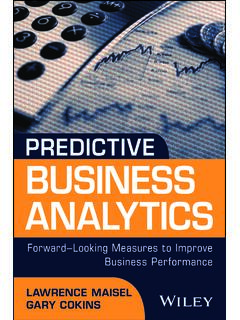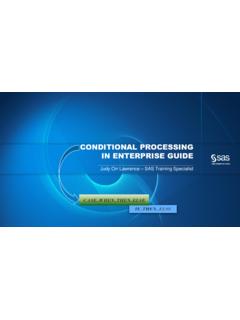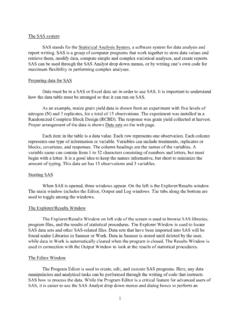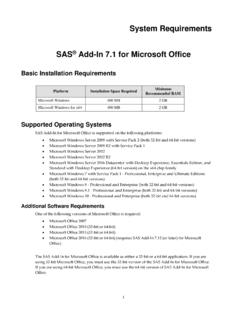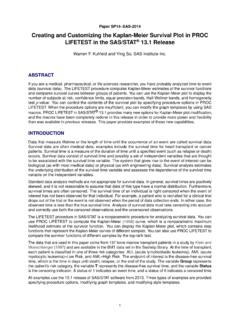Transcription of The 5 Essential Components of a Data Strategy Title
1 TitleWHITE PAPERThe 5 Essential Components of a data StrategyiiContentsData Strategy : What Problem Does It Solve? ..1 data : Past and Present ..2 The Business Without a data Strategy Defined ..4 The 5 Components of a data Strategy ..4 Identify ..8 Process ..9 Govern ..10 Defining a data Strategy Is Key ..12 The Power of a data Strategy ..12 Learn More ..13 Despite heavy, long-term investments in data management, data problems at many organizations continue to grow. One reason is that data has traditionally been perceived as just one aspect of a technology project; it has not been treated as a corpo-rate asset. Consequently, the belief was that traditional application and database planning efforts were sufficient to address ongoing data issues.
2 As our corporate data stores have grown in both size and subject area diversity, it has become clear that a Strategy to address data is necessary. Yet some still struggle with the idea that corporate data needs a comprehensive Strategy . There s no shortage of blue-sky thinking when it comes to organizations strategic plans and road maps. To many, such efforts are just a novelty. Indeed, organizations strategic plans often generate very few tangible results for organizations only lots of meetings and documentation. A successful plan, on the other hand, will identify realistic goals along with a road map that provides clear guidance on how to best get the job done.
3 Let s see how this played out in real life at one organization that set out to develop a data Strategy : What Problem Does It Solve?Consider the example of a consulting team helping a large bank to develop a data Strategy . From the start, the project champion had found it hard to get his VP to under-stand the need for and importance of a data Strategy . Why?The bank was already successful. Its revenue and costs were well-managed, and the individual business units and technology groups were good at delivering against their commitments. To the bank s credit, it wasn t complacent. Management was always looking for ways to increase staff members productivity and reduce ongoing costs.
4 There were all kinds of metrics and key performance indicators (KPIs) to measure IT performance, business benefits and total cost of ownership. The idea of building yet another road map to address a problem that wasn t well-understood met with pushback. The VP gave his explanation along with some questions: We ve got dozens of projects going on at any given time. We re very good at managing our storage needs, our application systems, the analytical plat-forms, software costs and individual project budgets. Every project identifies staff and resource costs, and we don t ever move forward without the business covering the costs. Why do we need a data Strategy ?
5 What problem will it solve? 12 With the bank doing so many things right, he needed to understand why and how a data Strategy would make a difference. To answer these questions, it s important to consider how data was created and used in the past compared to how it s created and used today. data : Past and PresentOnce upon a time, data was perceived as a byproduct of a business activity or process. It had little value after the process was completed. While there might have been one or two other applications that needed to access the content for follow-up ( , customer service, special reports, audits, etc.), these were usually one-off activities. Today, business is very different.
6 The value of data is accepted; the results of reporting and analytics have made data the secret sauce of many new business initiatives. It s common for application data to be shared with as many as 10 other systems. While the value of data has evolved tremendously over the past 20 years and business users recognize it few companies have adjusted their approaches to capturing, sharing and managing corporate data assets. Their behavior reflects an outdated, underlying belief that data is simply an application byproduct. Organizations need to create data strategies that match today s realities. To build such a comprehensive data Strategy , they need to account for current business and tech-nology commitments while also addressing new goals and Business Without a data StrategyThinking back to the story, the bank executive s concerns were not hard to understand.
7 He spent lots of time wading through project proposals that his devoted staff was incredibly emotional about. In many instances, his team s project proposals were about delivering perfection turning something that already worked into something faster, stronger or better. The executive understood the world of finite budgets and resources where any new approved project would ultimately take funding and resources away from another request. His mantra was well-known: Tell me why your idea is more important than the items already on the priority list. The consultants were prepared for this discussion. The issue was not related to the premise or value of any individual project.
8 The problem was the approach that each individual project and activity took. Each activity addressed data needs independently from one another without any awareness of the overlapping efforts and costs. Most projects required access to the same data content. Unfortunately, there was no coordination to prevent overlapping (and wasted) work. There was no data sharing, no data reuse, or any economies-of-scale activities to simplify or reduce the cost of data movement and development. 3 Business users accessed common data across separate applications. data value names and formatting varied across applications. Users found inconsistencies across reports because source data wasn t docu-mented, and it varied across individual result was duplicate data , processing overlaps and little awareness that individual projects were replicating work.
9 There wasn t anything in place to support communi-cating, collaborating or sharing data methods and practices across projects and systems. The problem: Every project at the bank addressed data issues as one-off, built-from-scratch activities. Case Study: The Bank s data ChallengesThe bank s IT team had 17 projects underway (new applications, appli-cation enhancements, new reports, etc.). Each project required access to customer data , and each had over-lapping tasks and resources. Every project included a source data inventory and analysis activity because there was no way to know where specific data resided. New data extracts (subsets of the application s data copied for use by other systems) had to be built because IT had no way of determining if the data was already available.
10 No two teams shared their source extract data . Each had their own copies to support their integration and database build activities (which tied up storage for this transient content). Each team s integration logic was custom built and individually main-tained, because the logic and rules weren t identified or documented to be business staff dependent on its own operational and reporting efforts had experienced other challenges: Marketing had to continually update its campaign system to adjust to frequent (and uncommunicated) changes occurring to the layouts of the extracts it received. Sales managers always had questions about KPI reports with customer details because titles and labels varied across reports (even though they contained common data ).







